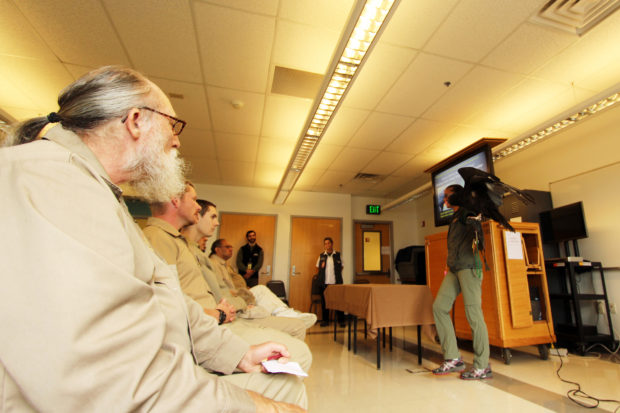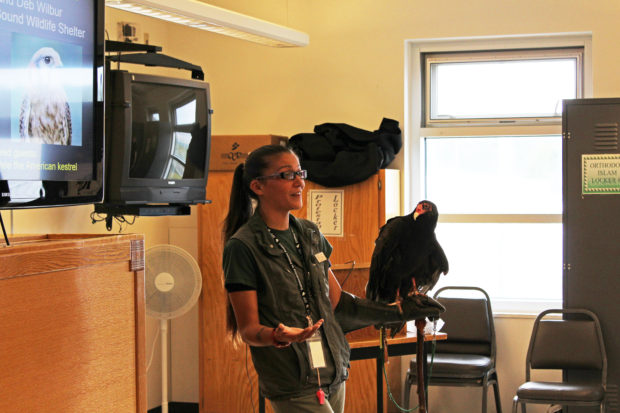Part Three: Session at the Women’s Prison
If you haven’t already read Part One, you can do so here, and Part Two is here.
Photos and text by Joslyn Rose Trivett, SPP Education and Outreach Manager

The WCCW visit room and sometimes-classroom is captured in the mirror at the front.
In January, we presented lecture survey results to students at the men’s prison, and gathered their feedback and ideas (that story here). We needed to repeat the process at Washington Corrections Center for Women (WCCW), but had to wait until there was an opening in the lecture series schedule. That time came in March.

As a part of the presentation, Liliana also gave an overview of SPP programs statewide and at WCCW.
The program classroom at WCCW can have a very different feel than the one at Stafford Creek Corrections Center. Lectures are held in the visit room. The layout is not ideal, and the buzz of vending machines can be a distraction. That day, we learned from the students that program demand is met just fine by the seats and sessions available—they aren’t clamoring for more, like we hear from the male students. While Stafford Creek has nearly 2,000 residents, WCCW has less than 800, and WCCW residents can choose from a relative abundance of programming. These factors likely contribute to a somewhat more casual classroom atmosphere than at the men’s prison.
Again, Liliana Caughman presented her report from the lecture series surveys, and again the students nodded with agreement at the results. However, this group was more quick to talk about a negative result: the small number of students (5%) who respond negatively to the lectures. A student self-identified as one of these, and I was glad to hear more from her when we broke into small groups: her critique was more acute than others’, but the particulars were similar to widely-expressed comments.
More engaging!

In my small group, we passed a talking piece to make sure everyone had chances to talk, and I think it made for a high quality discussion. A few students shielded themselves from potential germs by only handling the talking piece with the help of a napkin.
Liliana, Elijah Moloney, and I each sat with a third of the group to further discuss the program and program surveys. From nearly everyone in my group, I heard that they want more interactive and varied sessions. Several students said they struggle to sit still and pay attention through a 90 minute presentation. I heard that a short presentation is fine, and especially if it includes a way to take notes (we would need to provide the paper and pencils), humor, specimens, live animals, or video. They asked us to make time for writing, worksheets, quizzes on the content, games, and individual or small group exercises. Overall, they want content that’s more “sticky.” All this lead to the most potent suggestion: they aren’t very interested in lectures, so why not call the program something else?
Good point! I recall Sarah Weber’s research 2012 study that “… the lecture-style presentations appeared more effective for for male students, whereas workshop-style presentations appeared more effective for female students in improving inmate knowledge and attitudes on environmental topics.” More recent results from the men’s prison, including what we heard during the January session, point to a wide-spread preference for interactive, more engaging sessions. Lectures may be more effective at conveying information, at least for some groups, but workshops have a wide-spread, strongly positive effect on environmental attitudes.
Topics & Surveys
The students asked for sessions on sociology, psychology, communications, physiology, mental plasticity, and evolution. These are some of my favorite topics too.
Like the male students, they asked for more knowledge questions. A few suggested more variety in the questions about attitude, so that respondents are less likely to answer automatically.
What next?
I find it super satisfying to have extensive qualitative and quantitative results on the program; it makes it easy to decide what next! Here is what we will do:
-
Rename the program. Science and Sustainability Lecture Series has served us well for years, but it’s time for an upgrade. Program partners have agreed on Environmental Engagement Workshop Series.
- Update guidelines for guest presenters, with pointers on how to create inspiring, challenging, “sticky,” content.
- Recruit guests with expertise on social, political, physiological, and evolutionary aspects of the environmental field.
- Increase the number of knowledge questions on the surveys.
- Use a larger set of attitude questions, varying which are included each time; some questions will ask about identity and plans for action.
We have already started work on each of these actions. Liliana has started using the new name with guest presenters, and was pleased to see that the word “workshop” had the desired effect on their planning and facilitation.
I still recognize that seven years’ data from the Science and Sustainability Lecture Series showed us that the program has been enormously successful and well received. Now we are ready to make it even better!


 The students at Stafford Creek express interest in a huge variety of sustainability and environmental topics. New topic requests I heard were economic and political aspects of climate change—I agree that there is much to learn and consider in that arena! A few students spoke of their frustrations of not having their requests filled, or that they have missed the presentation when their request was met. Again, this points to the desire to increase program access and scope.
The students at Stafford Creek express interest in a huge variety of sustainability and environmental topics. New topic requests I heard were economic and political aspects of climate change—I agree that there is much to learn and consider in that arena! A few students spoke of their frustrations of not having their requests filled, or that they have missed the presentation when their request was met. Again, this points to the desire to increase program access and scope.























